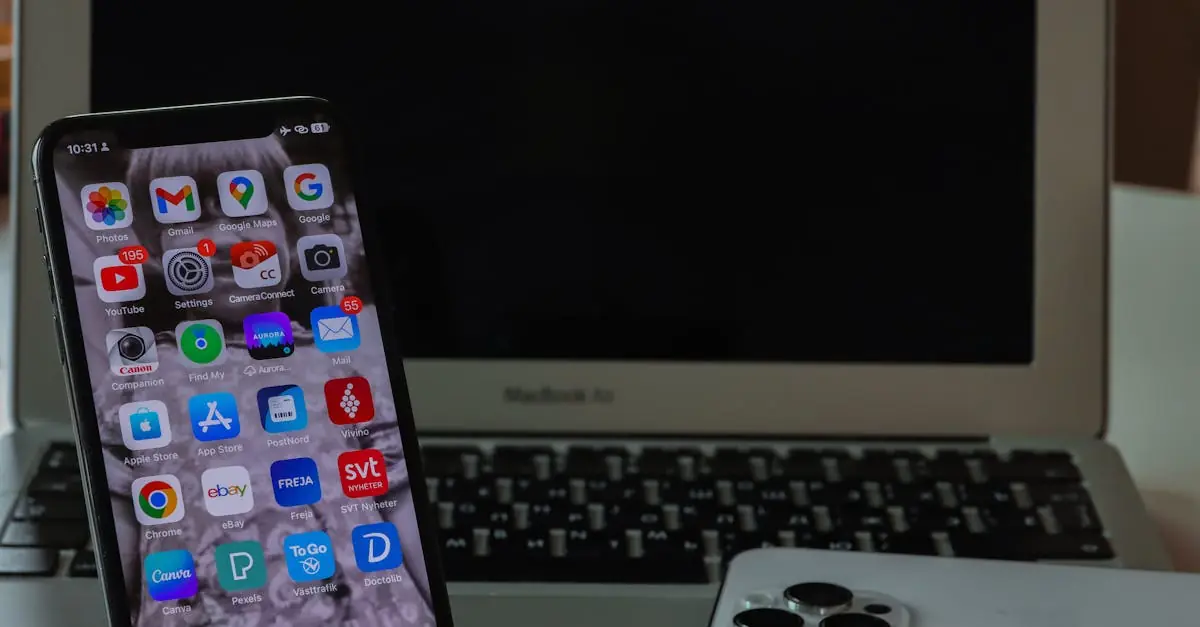Table of Contents
ToggleIs your iPhone 11 feeling more like an iPhone 1.1? If your battery’s barely making it through the day, it might be time for a replacement. But before you start Googling “how to charge my phone with a potato,” let’s talk about the cost of bringing your trusty device back to life.
Overview of iPhone 11 Battery Replacement
Replacing the battery in an iPhone 11 becomes essential when users encounter significant performance drops. Battery performance commonly deteriorates over time, leading to shorter usage periods between charges. Signs that indicate a battery replacement include rapid battery drain, unexpected shutdowns, or charging difficulties.
Apple provides battery replacement services through authorized service providers. Prices for a battery replacement typically range from $69 to $99, depending on warranty status. Users with AppleCare+ may incur reduced fees for battery service. Third-party repair shops often offer competitive pricing, usually between $50 and $80.
The iPhone 11 battery holds a capacity of 3,110 mAh, which supports effective usage under normal conditions. A degraded battery won’t deliver optimal performance, significantly impacting daily operations. Selecting a reliable service provider ensures quality parts and skilled repairs.
Replacement processes generally involve removing the device’s display, disconnecting the battery, and installing a new one. Professional technicians typically perform this procedure to minimize damage risk. DIY replacements are available for the tech-savvy but come with risks, including voiding warranties.
Long-term reliability often depends on battery health and care. Regular monitoring can provide insights into the battery’s condition. Users can check battery health in the Settings menu to assess if replacement is necessary. Proper usage habits will extend the overall lifespan of the battery, thus maximizing the iPhone 11’s performance.
Factors Affecting Battery Replacement Cost
Several factors influence the cost of replacing an iPhone 11 battery. Understanding these can help users make informed decisions.
Type of Replacement Service
Authorized service providers typically charge $69 to $99 for battery replacement. Third-party shops may offer lower prices, usually between $50 and $80. Variability in costs occurs based on service type and geographic location. Authorized providers guarantee the use of genuine Apple parts, ensuring compatibility and reliability. Third-party services might use aftermarket components, which can affect overall performance and longevity of the replacement. Users often prioritize quality assurance when selecting a service option.
Warranty and AppleCare Considerations
Warranty coverage can significantly affect battery replacement costs for iPhone 11 users. If a device is under warranty, Apple often covers battery replacements at no additional charge, provided certain conditions are met. AppleCare+ extends coverage beyond the warranty period and offers reduced fees for battery replacements. Users benefit from this service if their battery’s health degrades significantly within the coverage term. Reviewing existing warranty conditions can lead to potential savings, making it a critical consideration for users deciding on battery replacement.
DIY vs. Professional Replacement
Many users explore DIY battery replacement options for the iPhone 11. This route offers potential savings and the satisfaction of completing a task independently.
Pros and Cons of DIY Replacement
Pros of DIY replacement include cost savings and convenience. Some users appreciate saving between $50 and $80 using online kits and guides. Flexibility in scheduling adds to the appeal, allowing individuals to replace the battery at their convenience. Yet, there are cons to consider. Performing a DIY replacement often voids warranties and poses risks to device integrity. Mishandling tools may cause damage to other components, leading to additional costs.
Costs Associated with DIY Replacement
Costs for DIY battery replacements range from $20 to $50 for battery kits. These kits typically include necessary tools and instructions. However, users might face hidden costs. Accessory purchases, such as adhesives or replacement parts, might add an extra $10 to $20. It’s important to weigh the potential savings against risks of additional expenses in case of mistakes. Professionals, while more expensive, guarantee the use of genuine Apple parts, ensuring device longevity.
Average Costs for Battery Replacement
Costs for replacing the iPhone 11 battery vary significantly based on the service provider used. Users often find that prices influence their choices.
Apple Store Pricing
Apple’s official battery replacement service generally charges $69. This cost includes the use of genuine Apple parts and professional installation, ensuring device reliability. Customers appreciate the added peace of mind that comes with utilizing Apple’s technicians. Additionally, users should consider the option of battery replacement under warranty or AppleCare, as these programs may yield reduced costs or, in some cases, free replacement services. Engaging directly with Apple can clarify the specifics regarding eligibility.
Third-Party Repair Options
In contrast, third-party repair shops typically charge between $50 and $80 for battery replacement. This can save users money, with many shops offering competitive pricing to attract business. However, quality may vary significantly among providers. Some shops use aftermarket parts which may not deliver the same longevity or performance as genuine Apple components. Despite the potential savings, users should weigh the risks of using third-party services against the assurance that comes from Apple’s authorized repairs. Checking reviews and asking about part quality before proceeding with a third-party service can help ensure satisfactory results.
Ensure Quality and Safety in Battery Replacement
Prioritizing quality and safety during the iPhone 11 battery replacement process is essential. Authorized service providers guarantee the use of genuine Apple components, ensuring optimal performance. Choosing this route often costs between $69 and $99, but users gain peace of mind from professional installation.
Consulting customer reviews can provide insight into third-party repair shops, which range from $50 to $80. While these alternatives might offer savings, part quality can vary significantly. Some users have reported issues with aftermarket batteries, impacting device longevity and performance.
Engaging professional technicians minimizes risks associated with installation. They possess the expertise required to avoid damage during the battery replacement. However, for the adventurous, many choose DIY kits, priced between $20 and $50. Users who opt for this method must be cautious, as improper installation can void warranties.
Battery health monitoring through the Settings menu plays a crucial role in determining the need for replacement. Frequent checks help identify performance drops, such as rapid battery drain or unexpected shutdowns. Acting promptly in these cases can prevent further complications.
Warranty coverage through Apple or AppleCare+ may qualify the device for free or reduced-cost battery replacements. Devices under warranty always receive priority service, enhancing overall user experience. Weighing the benefits of authorized services against potential savings from DIY options enables informed decisions regarding battery replacements.
Replacing the battery in an iPhone 11 can significantly enhance its performance and extend its lifespan. Users should carefully evaluate their options whether they choose authorized service providers or consider DIY replacements. While cost savings are tempting with third-party shops or DIY kits, the risks associated with quality and warranty voiding shouldn’t be overlooked. Regularly monitoring battery health is crucial for identifying when a replacement is necessary. Ultimately, making an informed decision based on individual needs and circumstances can lead to a better user experience and a more reliable device.





